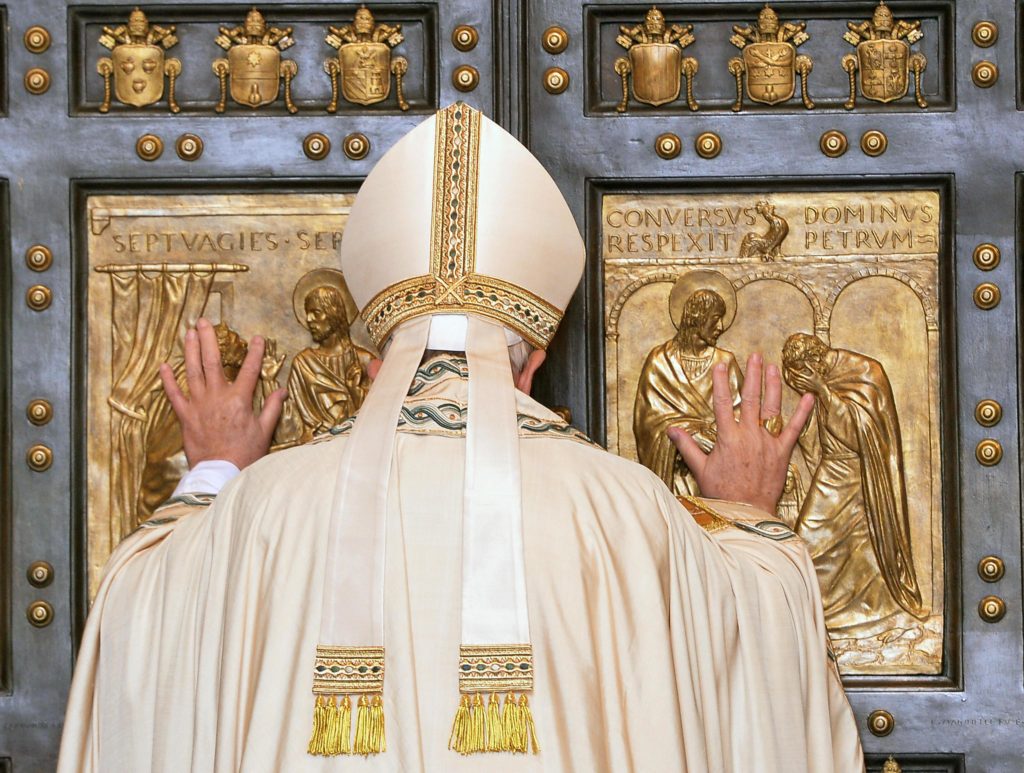ROME — Years from now, records will show that the special jubilee Year of Mercy decreed by Pope Francis began on Dec. 8, 2015, the feast of the Immaculate Conception. If you ask the pontiff himself, however, he’d probably tell you it really got underway on Friday.
That afternoon, Francis headed across town to visit a hostel for the homeless run by Caritas, the main diocesan charity in Rome, in order to open a “holy door of charity.” In a sense, it was the natural follow-up to what happened on Dec. 8, when Francis threw open an ornate door to St. Peter’s Basilica that’s otherwise bricked up when jubilees aren’t underway.
That gesture traditionally is how jubilee years commence, but Friday’s rite was a novelty — a pontiff opening a door not to a church, where spiritual indulgences are on offer, but rather a charity center, where the “grace” dispensed is more tangible and this-worldly.
Anyone who spends time watching Francis in action realizes he doesn’t particularly care for big ceremonial productions. He’s most comfortable in smaller, more intimate settings, especially with people who don’t qualify as VIPs, where he can set aside whatever speech has been prepared for him and go off-the-cuff in Spanish or Italian.
Celebrating Mass on Friday for a group of 200 people representing the various activities run by Caritas in Rome — homeless people, AIDS patients, mothers with developmentally challenged children, refugees, and so on — was, to hear Francis tell it, an expression of the heart of what the Year of Mercy is supposed to be all about.
“If you want to find God, you have to seek him in humility, in poverty, where he’s hidden — in the needy, the neediest, the sick, the hungry, the prisoners,” he said.
The hostel Francis visited Friday afternoon is named for Don Luigi di Liegro, the founder of Caritas in Rome who ran it until his death in 1997. He was famed for bringing together disparate groups — the Salvation Army, Mother Teresa’s Sisters of Charity, Sant’Egidio, among others — into an effective network to serve the city’s poor, its immigrant population, and people often ignored by public institutions, such as residents with mental and psychological difficulties.
The fact that Francis was at home there, however, didn’t mean all was sweetness and light. On the contrary, the pontiff sounded almost like an Old Testament prophet in warning affluent and comfortable Romans about the consequences of indifference.
“Jesus has told us how our judgment will be,” Francis said. “He won’t say: ‘You, come with me because you gave lots of beautiful offerings to the Church, you were a benefactor of the Church, so come into Heaven.’ No, you can’t buy your way into Heaven,” Francis said.
“Jesus won’t say: ‘You were very important, you studied a lot and earned many honors, come into Heaven.’ No. Honors don’t open the door of Heaven.
“What will Jesus say? ‘I was hungry and you gave me something to eat; I was homeless and you gave me a place to live; I was sick and you visited me; I was in prison and you came to see me’.”
Francis offered up a prayer that the Lord will help everyone grasp that “the paths of presumption, of wealth, of vanity, of pride, are not the ways to salvation.”
Looking out at a group of people typically seen as “discarded” by society, Francis said that feeling of being tossed aside is actually a “grace.”
“It would be beautiful if every one of us, all Romans, felt discarded, and thus felt the need of God’s help,” the pontiff said.
Francis celebrated the Mass along with four other priests, including the Rev. Tommas Fanti, who, at 96, is still going strong in serving Rome’s poor. The readings and prayers of the faithful were presented by the people whom Caritas serves; the prayers were actually written by a young mother with a disabled child, a refugee requesting asylum in Italy, and a homeless person living in the hostel Francis was visiting.
Basically, the pope’s message was that these folks are not only what the Year of Mercy is all about, but also the Christmas season.
“In choosing how he’d lead his [human] life, the Lord didn’t pick a great city with a grand empire, he didn’t pick a princess or a countess for his mother, somebody important, and he didn’t choose a luxurious palace,” Francis said.
“It seems that it was all done intentionally,” he said, referring to the Christmas story of Jesus’ birth, in order that the Lord would be “hidden” by the usual worldly standards.
Upon leaving the hostel, Francis urged people to go forward during the jubilee year in an “embrace of mercy.”
Over the coming days, Francis will conduct any number of important engagements: his annual speech to the Roman Curia, the Christmas liturgies, his New Year’s Day Urbi et Orbi blessing, a meeting with the diplomatic corps, and so on.
In terms of getting to the core of what he wants his jubilee year to be about, however, it’s hard to imagine that for him anything will top Friday’s encounter with the “hidden” and “discarded” who clearly form this pope’s comfort zone.
....
Taken from: http://www.cruxnow.com/church/2015/12/19/pope-francis-was-in-his-element-when-he-opened-the-door-of-charity-for-the-poor/




 Image copyright AFP/Reuters
Image copyright AFP/Reuters Image copyright AFP
Image copyright AFP Image copyright AP
Image copyright AP